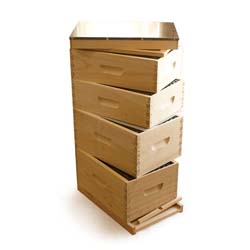During warmer months, honeybees typically relieve themselves while they are out foraging for resources, usually quite far from the hive. In the winter, however, you may see signs of bees relieving themselves just outside the front of the hive entrance. Noting a few yellow or brown spots in the snow by the hive is normal but seeing evidence of excessive dark fecal matter staining inside or on the outside wall of a beehive is not.
Honeybees will do everything they can to go to the bathroom essentially anywhere that’s NOT the inside of their hive. They are a hygienic species and intuitively know that waste building up in their home can lead to an increase in disease and poor colony health. On days when temperatures reach 40 degrees F or above, honeybees will instead take short “cleansing flights” to relieve themselves away from the entrance and inside of their hive. (See the “Read More” section below for more on “Cleansing Flights”)
Until bees can relieve themselves outside the hive (even through much of the winter), they will hold waste inside their digestive tract. If a very long period of cold weather prevents bees from taking cleansing flights, they may become stressed and develop dysentery (in extreme cases). This causes bees to be unable to hold in their waste, giving them no choice but to defecate inside the hive.
If you note signs of bees expelling excessive fecal waste, especially when they are found inside the hive, it should always prompt you to investigate the cause further. Some diseases or parasitic infections can cause dysentery and are a big threat to the colony’s health, such as the disease “Nosema” *.
(*Colony Members, see the “Read More” section below to find the Academy lesson that covers Nosema)
Read More
An Introduction to Nosema and Chalkbrood*
* Colony Member-Only Content
